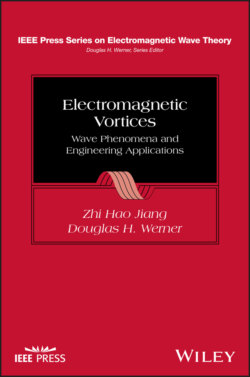Читать книгу Electromagnetic Vortices - Группа авторов - Страница 17
1.2 OAM Beams; Properties and Analogies with Conventional Beams
ОглавлениеHelically phased beams exhibit two unique properties: (i) the orthogonality of different OAM modes and (ii) the OAM beam divergence. As we will discuss in Section 1.3, the infinite number of orthogonal OAM modes provides an additional set of data carriers, thus OAM has the potential to increase the capacity and spectral efficiency of wireless communication links [4]. The beam divergence can be advantageous for applications that require cone‐shaped patterns, such as satellite‐based navigation and guidance systems that serve moving vehicles [5] but may also pose a challenge for long‐distance communication links [6]. In the subsequent paragraphs, these two peculiar features are explicated, and a comparative study between conventional and OAM beams is performed to underline their differences.
The first characteristic property of OAM beams is the orthogonality of distinct OAM modes. In general, the electric field of an OAM beam can be written as:
(1.1)
where ρ is the radial distance, ϕ is the azimuthal angle, and z is the propagation distance in the cylindrical coordinate system. There exist various subsets of OAM‐carrying beams, for example Laguerre–Gaussian [3], Bessel–Gaussian [7], hypergeometric–Gaussian [8], vector vortex [9], and other beams [10]. The radial distribution A(ρ, z) in Eq. (1.1) defines the special subset among all OAM‐carrying beams. All the previous beams carry the ejlϕ term, which gives rise to an OAM mode of l‐order. If we consider the electric fields E1(ρ, ϕ, z), E2(ρ, ϕ, z) of two OAM beams with modes l1, l2, and radial distributions A1(ρ, z), A2(ρ, z), the following orthogonality relation is satisfied [11]:
(1.2)
where the asterisk (*) denotes the complex conjugate. It follows that: (i) there is an infinite number of OAM modes, with each mode identified by the mode number l, and (ii) the infinite set of OAM states forms an orthogonal basis.
The second special feature of OAM beams is the beam divergence. The far‐field signature of the helical wavefront is an amplitude null at the phase vortex center. Accordingly, the null size can be described in terms of a divergence angle, which represents the angle from the null to the maximum gain [12]. As the OAM beam travels through space, the radius of the ‘dark zone’ around the amplitude null in the center of the beam increases.
